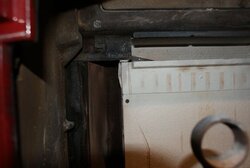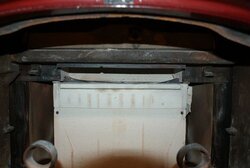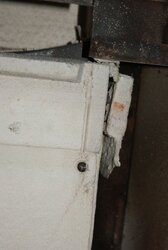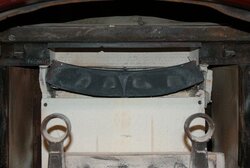Got this stove newly installed in January or February. Removed the fireback to get a look at the catalyst, and this is what I found. I thought everything was working just fine till I saw this. Now I'll get to see how VC is on warranty service, as I'll also email these to my dealer/installer. Besides the obvious, the catalyst is quite bowed and badly cracked.
VC Encore Cat - Behind the Fireback
- Thread starter JV_Thimble
- Start date
-
Active since 1995, Hearth.com is THE place on the internet for free information and advice about wood stoves, pellet stoves and other energy saving equipment.
We strive to provide opinions, articles, discussions and history related to Hearth Products and in a more general sense, energy issues.
We promote the EFFICIENT, RESPONSIBLE, CLEAN and SAFE use of all fuels, whether renewable or fossil.
You are using an out of date browser. It may not display this or other websites correctly.
You should upgrade or use an alternative browser.
You should upgrade or use an alternative browser.
- Status
- Not open for further replies.
Wow, sorry to hear this. Is the downward force of the bowing what you think is fracturing the refractory assembly?
certified106
Minister of Fire
I seem to remember a thread this winter where there was some talk of the first cats that were made for these stoves being slightly to large and causing problems so maybe that's the case on this one. Hopefully someone will remember which thread it was that they were talking about this in. Sorry to hear about the problems though.
Blue Vomit
Minister of Fire
certified106 said:I seem to remember a thread this winter where there was some talk of the first cats that were made for these stoves being slightly to large and causing problems so maybe that's the case on this one. Hopefully someone will remember which thread it was that they were talking about this in. Sorry to hear about the problems though.
That was in the newer 2n1's
https://www.hearth.com/econtent/index.php/forums/viewthread/66655/P110/ Page 6
Good luck
Thanks for all the replies. Just hoping I can get this fixed quickly enough for one of those early fall fires.
Not sure on why the catalyst is bowed like that, but I have to believe that this wouldn't have looked right if I'd removed the fireback before the first fire.
Will definitely keep you guys posted on this - maybe I have an unusual case here.
Not sure on why the catalyst is bowed like that, but I have to believe that this wouldn't have looked right if I'd removed the fireback before the first fire.
Will definitely keep you guys posted on this - maybe I have an unusual case here.
Gark
Minister of Fire
Sad to see that. Is the roof of the refractory box whole and in the right position? If not, it looks like something heavy got dropped down the stovepipe collar (with the damper closed) and smashed the refractory? During transport for example. The refractory material in our 2550 is very fragile. Or the refractory was installed AFTER the upper fireback was installed
(Bass ackwards).
(Bass ackwards).
Gark said:Sad to see that. Is the roof of the refractory box whole and in the right position? If not, it looks like something heavy got dropped down the stovepipe collar (with the damper closed) and smashed the refractory? During transport for example. The refractory material in our 2550 is very fragile. Or the refractory was installed AFTER the upper fireback was installed
(Bass ackwards).
I think I'll have to rely on the dealer/installer to answer these. I don't really know what I'd be looking for, as I don't have a reference stove that's set up properly.
JV_Thimble said:Thanks for all the replies. Just hoping I can get this fixed quickly enough for one of those early fall fires.
Not sure on why the catalyst is bowed like that, but I have to believe that this wouldn't have looked right if I'd removed the fireback before the first fire.
Will definitely keep you guys posted on this - maybe I have an unusual case here.
It looks like the cat fit was too tight. As it heated up it expanded and had no option but to push outward. When that didn't work, it bowed, shoving out the sides of the refractory.
elmoleaf
Feeling the Heat
Reference an exploded parts diagram for your stove. It's critical to understand how these parts go together so you'll know if something is amiss during annual maintenance/inspections.
The piece directly in front of the cat is removable to allow insertion/removal of the cat from the refractory chamber. The chamber is an expensive part for something seemingly so simple.
Depending on how badly the sides pushed out, it may be possible to use furnace cement to reattach the displaced parts. I'd try to get them to replace both the cat and the refractory box.
If possible, keep the old box and fix it yourself for use as a spare.
The piece directly in front of the cat is removable to allow insertion/removal of the cat from the refractory chamber. The chamber is an expensive part for something seemingly so simple.
Depending on how badly the sides pushed out, it may be possible to use furnace cement to reattach the displaced parts. I'd try to get them to replace both the cat and the refractory box.
If possible, keep the old box and fix it yourself for use as a spare.
Todd
Minister of Fire
Todd said:Is that the new Encore 2 in 1?
It's the 2550, which I don't think is the same.
elmoleaf said:Reference an exploded parts diagram for your stove. It's critical to understand how these parts go together so you'll know if something is amiss during annual maintenance/inspections.
The piece directly in front of the cat is removable to allow insertion/removal of the cat from the refractory chamber. The chamber is an expensive part for something seemingly so simple.
Depending on how badly the sides pushed out, it may be possible to use furnace cement to reattach the displaced parts. I'd try to get them to replace both the cat and the refractory box.
If possible, keep the old box and fix it yourself for use as a spare.
Had a very knowledgeable sweep out yesterday, and he removed that piece in front of the cat. I'll try and post a picture soon, as it's now much easier to see what's happened back there.
And the dealer is filing a warranty claim, so I had to pull out the exploded parts diagram to determine what parts were needed.
Not a bad idea to keep the old part if you can for possible repair. But it's also pretty amazing how fragile this stuff seems to be.
Todd
Minister of Fire
Wow, major sag there. I do remember some other Encore owners that had similar problems with the new steel cats warping but not like that. Looks like VC should have a better can or frame to hold the cat so it doesn't warp. I bet they fixed this with the new 2 in 1.
BrowningBAR
Minister of Fire
JV_Thimble said:Much more to look at with the bit of refractory that sits in front of the cat taken out.
That's a shame. Let's hope VC steps up and corrects the issue.
BeGreen said:That cat had no room to expand with the heat.
That's what it looks like to me. Like maybe the cat was not quite set properly in the slot for it in the refractory. More like jammed in a bit high. Then, some heat, and, voila!
That's my guess, anyway.
jimbom
Combustion Analyzer
Steel melts around 1500 °C. The coefficient of linear expansion of steel is 0.000012 in/in °C. A 12 in long steel combustor would expand ~ 0.22 inches from zero to 1500 °C. This combustor approached melting. Does a magnet stick to this combustor?
It should have been made of stainless steel which melts around the same temperature 1500 °C. Expansion for stainless would be about 0.3 inches for a 1500 °C rise.
1500 °C is about 2700 °F.
It should have been made of stainless steel which melts around the same temperature 1500 °C. Expansion for stainless would be about 0.3 inches for a 1500 °C rise.
1500 °C is about 2700 °F.
raybonz
Minister of Fire
JimboM said:Steel melts around 1500 °C. The coefficient of linear expansion of steel is 0.000012 in/in °C. A 12 in long steel combustor would expand ~ 0.22 inches from zero to 1500 °C. This combustor approached melting. Does a magnet stick to this combustor?
It should have been made of stainless steel which melts around the same temperature 1500 °C. Expansion for stainless would be about 0.3 inches for a 1500 °C rise.
1500 °C is about 2700 °F.
Holy cow Einstein that's some serious heat! I ran a cat stove for a long time and never went past 1700 degrees F (maybe once or twice for a very short time with a brand new cat).. Not sure how you get that much unless you're burning nuclear fuel rods lol.. I would think you'd need to inject pure oxygen into a cat to achieve 2700 degrees..
Ray
JimboM said:Steel melts around 1500 °C. The coefficient of linear expansion of steel is 0.000012 in/in °C. A 12 in long steel combustor would expand ~ 0.22 inches from zero to 1500 °C. This combustor approached melting. Does a magnet stick to this combustor?
It should have been made of stainless steel which melts around the same temperature 1500 °C. Expansion for stainless would be about 0.3 inches for a 1500 °C rise.
1500 °C is about 2700 °F.
I love the odd coefficient of expansion units - in/in °C. A mixture of US units and metric.
On the temperature, I never saw operating temps above about 700 F using a stovetop temp gauge and an IR themometer. Manual says not to go over 800, so I paid attention to that. Tried to run the stove generally between 450 and 600, as 450 is what you need to ignite the cat.
A magnet does stick to the cat.
[/quote]
Holy cow Einstein that's some serious heat! I ran a cat stove for a long time and never went past 1700 degrees F (maybe once or twice for a very short time with a brand new cat).. Not sure how you get that much unless you're burning nuclear fuel rods lol.. I would think you'd need to inject pure oxygen into a cat to achieve 2700 degrees..
Ray[/quote]
Agreed, and I don't have a pure oxygen system. I do have an OAK, but that won't quite do it.
Holy cow Einstein that's some serious heat! I ran a cat stove for a long time and never went past 1700 degrees F (maybe once or twice for a very short time with a brand new cat).. Not sure how you get that much unless you're burning nuclear fuel rods lol.. I would think you'd need to inject pure oxygen into a cat to achieve 2700 degrees..
Ray[/quote]
Agreed, and I don't have a pure oxygen system. I do have an OAK, but that won't quite do it.

raybonz
Minister of Fire
Holy cow Einstein that's some serious heat! I ran a cat stove for a long time and never went past 1700 degrees F (maybe once or twice for a very short time with a brand new cat).. Not sure how you get that much unless you're burning nuclear fuel rods lol.. I would think you'd need to inject pure oxygen into a cat to achieve 2700 degrees..
Ray[/quote]
Agreed, and I don't have a pure oxygen system. I do have an OAK, but that won't quite do it.
 [/quote]
[/quote]JV do you find an OAK makes a big difference? Some ppl really think they are the way to go.. My house is snug but not airtight..
Ray
jimbom
Combustion Analyzer
JV_Thimble said:JimboM said:Steel melts around 1500 °C. The coefficient of linear expansion of steel is 0.000012 in/in °C. A 12 in long steel combustor would expand ~ 0.22 inches from zero to 1500 °C. This combustor approached melting. Does a magnet stick to this combustor?
It should have been made of stainless steel which melts around the same temperature 1500 °C. Expansion for stainless would be about 0.3 inches for a 1500 °C rise.
1500 °C is about 2700 °F.
I love the odd coefficient of expansion units - in/in °C. A mixture of US units and metric.
...
A magnet does stick to the cat.
Normally, a magnet will not be attracted to stainless. Perhaps your cat was made from steel.
On the units thing: Couldn't decide if the Vermont Castings in the picture was made by the Canadian VC company or the American VC company. So I had to use units from both. To be fair and all that.
raybonz said:
Holy cow Einstein that's some serious heat! I ran a cat stove for a long time and never went past 1700 degrees F (maybe once or twice for a very short time with a brand new cat).. Not sure how you get that much unless you're burning nuclear fuel rods lol.. I would think you'd need to inject pure oxygen into a cat to achieve 2700 degrees..
Ray
Agreed, and I don't have a pure oxygen system. I do have an OAK, but that won't quite do it.
 [/quote]
[/quote]JV do you find an OAK makes a big difference? Some ppl really think they are the way to go.. My house is snug but not airtight..
Ray[/quote]
I have an old drafty house. Decided to do the OAK 'just because' while I was at having a new liner and stove installed. I like, it but it's probably just an attachment.
JimboM said:JV_Thimble said:JimboM said:Steel melts around 1500 °C. The coefficient of linear expansion of steel is 0.000012 in/in °C. A 12 in long steel combustor would expand ~ 0.22 inches from zero to 1500 °C. This combustor approached melting. Does a magnet stick to this combustor?
It should have been made of stainless steel which melts around the same temperature 1500 °C. Expansion for stainless would be about 0.3 inches for a 1500 °C rise.
1500 °C is about 2700 °F.
I love the odd coefficient of expansion units - in/in °C. A mixture of US units and metric.
...
A magnet does stick to the cat.
Normally, a magnet will not be attracted to stainless. Perhaps your cat was made from steel.
On the units thing: Couldn't decide if the Vermont Castings in the picture was made by the Canadian VC company or the American VC company. So I had to use units from both. To be fair and all that.
I've got to do some reading on why stainless does not attract a magnet. It's one of the thing I didn't like when we got a stainless steel fridge, and my wife loved.
There is mention of Paris, Kentucky on the stove back - but I can't tell if that's where it was made. I suspect they would be using the US units there. Definitely got a kick out of the mixed units, though.
- Status
- Not open for further replies.
Similar threads
- Replies
- 6
- Views
- 507
- Replies
- 4
- Views
- 3K
- Replies
- 1
- Views
- 778
- Replies
- 8
- Views
- 1K





